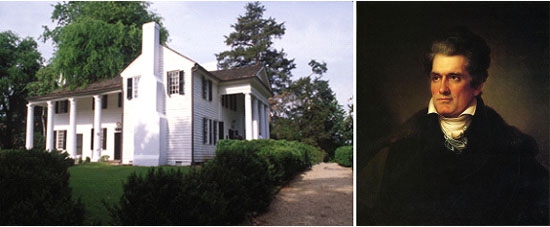|
Clemson University has awarded painting of historic Calhoun Mansion and Fort Hill—a National Historic landmark—to Greentree Corp., of Seneca, SC.
The contract is for $20,950. The contractor was required to have experience in completing historic restoration projects to perform the work on the campus, in Clemson, SC.
 |
|
Clemson University (left); Rembrandt Peale painting, 1834 (right) |
| The Calhoun Mansion is named for John Caldwell Calhoun, U.S. Vice President under John Quincy Adams and Andrew Jackson. The original home was expanded and, about 1830, renamed Fort Hill. |
Scope of Work
The project involves washing the house with a soft wash and cleaner to remove mold.
The house is to be wet-scraped and sanded, with all loose paint captured in university-provided disposal containers. Some of the existing paint contains lead.
The project also requires caulking with acrylic latex caulk all areas where water may intrude; reglazing windows as needed; and priming all raw wood.
Lime wash will be applied to all masonry surfaces. Metal rails will be primed and painted; porches, wood rails, and other wood surfaces will be painted with a variety of specified coating systems.
About the Site
Fort Hill was the home of John Caldwell Calhoun (1782-1850), U.S. Vice President under both John Quincy Adams and Andrew Jackson. Calhoun was also a senator, secretary of state and famous orator.
The mansion, originally known as Clergy Hall, was built in 1803 as the residence for nearby Old Stone Church. The architect is unknown. It was later purchased by the mother of Floride Calhoun, John Calhoun’s wife, and the couple eventually inherited it.
After John and Floride Calhoun died, the home and its 1,341 acres of land went to their daughter, Anna Maria, who married Thomas Clemson. He inherited the property when she died and willed that Fort Hill “shall always be open for the inspection of visitors.” The land would become the home of Clemson University.
Today, the antebellum plantation home, office and kitchen are still furnished mostly with family artifacts. After an extensive two-year restoration project, Fort Hill reopened in spring 2003 for its bicentennial year.
Reported by Paint BidTracker, a construction reporting service devoted to identifying contracting opportunities for the coatings community. Visit us on Facebook!
|

 Follow us on Twitter
Follow us on Twitter
 Join us on Facebook
Join us on Facebook









